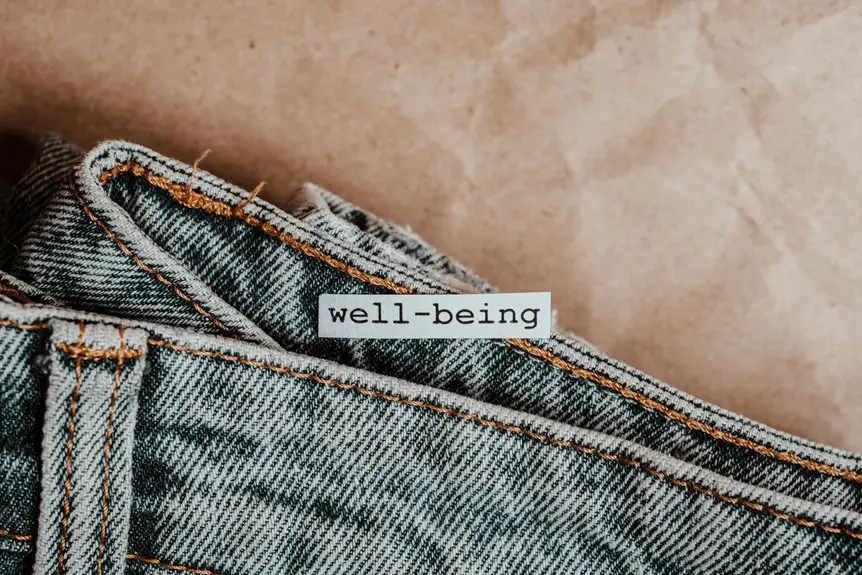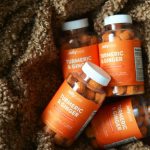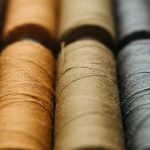Polypropylene fabric is a lightweight, durable synthetic material made from polymerized propylene. You’ll find it in various forms like non-woven, woven, melt-blown, and spunbond, each suited for uses from activewear to industrial packaging. Its composition gives it moisture-wicking, chemical-resistant, and quick-drying properties, making it popular for many applications. While it’s tough and easy to maintain, it has some limits like poor UV resistance. Keep exploring to uncover how its unique features match different needs.
Table of Contents
Key Takeaways
- Polypropylene fabric is a synthetic polymer known for strength, durability, moisture-wicking, and resistance to chemicals and mildew.
- Its semi-crystalline molecular structure combines crystalline stiffness with amorphous flexibility, enhancing durability and chemical resistance.
- Manufacturing involves melting pellets, extrusion into fibers, cooling, stretching, spinning, and weaving or knitting into fabric.
- Types include non-woven, woven, melt-blown, and spunbond polypropylene, each suited for different applications like medical masks or shopping bags.
- Polypropylene fabric is lightweight, moisture-resistant, stain-resistant, but has poor UV resistance and low melting point limitations.
Understanding Polypropylene as a Synthetic Polymer
Polypropylene stands out as a versatile synthetic polymer widely used in various industries. When you choose polypropylene fabric, you’re opting for a material known for its strength, durability, and resistance to many chemical solvents, acids, and bases.
You’ll find it in products ranging from packaging to textiles because it’s lightweight and moisture-wicking, making it ideal for activewear and outdoor gear. Unlike natural fibers, polypropylene doesn’t absorb water, so it dries quickly and resists mold and mildew, keeping your fabric fresh longer.
You’ll also appreciate its ability to withstand repeated washing without losing shape or performance. Understanding these practical qualities helps you see why polypropylene is a popular choice for fabrics designed to perform under demanding conditions.
Chemical Structure of Polypropylene Fabric
You’ll notice that polypropylene fabric’s strength comes from its unique molecular arrangement.
Its polymer chains are tightly packed and aligned, giving the fabric durability and flexibility.
Understanding these chain characteristics helps explain why polypropylene performs so well in various applications.
Molecular Arrangement
Although it may seem simple at first, understanding the molecular arrangement reveals why polypropylene fabric performs so well in various applications. The molecules in polypropylene align in a semi-crystalline structure, giving the fabric its strength and flexibility. This arrangement affects how the fabric behaves under stress, heat, and moisture.
Here’s what you should know about polypropylene’s molecular layout:
- The molecules are arranged in a helical pattern, enhancing durability.
- Crystalline regions provide stiffness, while amorphous areas add flexibility.
- This structure resists chemical breakdown, making it highly durable.
- It helps the fabric repel water, contributing to its moisture-wicking properties.
Knowing this helps you appreciate why polypropylene is ideal for activewear, upholstery, and industrial uses.
Polymer Chain Characteristics
Understanding the molecular arrangement sets the stage for exploring the specific characteristics of polypropylene’s polymer chains.
You’ll find that polypropylene consists of long chains of repeating propylene units, each made up of carbon and hydrogen atoms. These chains are semi-crystalline, meaning they’ve both ordered and amorphous regions, which gives polypropylene its strength and flexibility.
The tacticity—or the spatial arrangement of methyl groups along the chain—plays a vital role. Isotactic polypropylene, where methyl groups align on the same side, forms highly crystalline, durable fibers. Atactic polypropylene, with random methyl group placement, remains amorphous and less useful for fabric.
How Polypropylene Fabric Is Manufactured
When you plunge into the manufacturing of polypropylene fabric, you’ll find it starts with melting the polypropylene pellets into a thick, viscous liquid.
Next, this liquid undergoes extrusion, where it’s pushed through fine spinnerets to form long continuous fibers. These fibers are then cooled and solidified rapidly.
Afterward, the fibers are stretched to align their molecular chains, enhancing strength and flexibility.
Here’s what happens next:
- Fibers get crimped to add texture and bulk
- They’re spun into yarns suitable for weaving or knitting
- Fabric is formed by weaving or knitting these yarns
- Finally, the fabric often goes through heat setting to stabilize its shape
This controlled process guarantees the fabric’s durability and versatility in various applications.
Key Properties of Polypropylene Material
Once the polypropylene fabric is manufactured, its unique properties come into play, defining how it performs in different uses.
You’ll find it lightweight yet incredibly strong, which makes it durable without weighing you down. It’s also moisture-resistant, so it repels water instead of absorbing it, keeping you dry.
The fabric doesn’t easily absorb stains, making it easy to clean and maintain. Polypropylene also boasts excellent chemical resistance, so it won’t degrade when exposed to many solvents and acids.
Plus, it has good insulation properties, helping retain heat when needed. You’ll notice it resists stretching and shrinking, maintaining its shape over time.
These key characteristics make polypropylene a versatile and reliable material for various applications.
Common Uses of Polypropylene Fabric
You’ll find polypropylene fabric in many places, from your workout clothes to everyday apparel.
It’s also widely used in industrial settings and around the house for items like upholstery and reusable bags.
Let’s explore how this versatile material fits into your daily life.
Apparel and Activewear
Although polypropylene fabric isn’t as well-known as cotton or polyester, it’s quickly becoming a favorite in apparel and activewear. You’ll find it especially useful because it’s lightweight, moisture-wicking, and resists odors.
When you wear polypropylene clothing, you stay dry and comfortable during intense workouts or outdoor activities. Its durability means your gear lasts longer, even with frequent washing.
Here’s why you might choose polypropylene for your activewear:
- Excellent moisture management keeps sweat away from your skin
- Lightweight feel enhances comfort during exercise
- Quick-drying properties perfect for outdoor adventures
- Natural resistance to odors keeps your clothes fresher
If you want reliable, performance-driven apparel, polypropylene is a smart choice.
Industrial and Household Applications
Beyond its role in activewear, polypropylene fabric finds a wide range of uses in both industrial and household settings.
You’ll often see it in packaging materials, like reusable bags and sacks, thanks to its strength and resistance to moisture. In construction, it’s used for insulation and protective coverings because it can withstand harsh conditions.
At home, polypropylene shows up in carpets, upholstery, and furniture coverings, providing durability and easy cleaning. You might also find it in storage containers or even reusable food wraps due to its lightweight and non-toxic properties.
Its resistance to chemicals and mildew makes it ideal for items exposed to moisture or frequent washing.
Types of Polypropylene Fabrics Available
When exploring polypropylene fabrics, you’ll find several types designed for different uses and performance needs. Each type offers unique benefits depending on your project, whether it’s for clothing, industrial gear, or household items.
Here are some common types you might encounter:
- Non-woven polypropylene: Lightweight and breathable, ideal for medical masks and disposable garments.
- Woven polypropylene: Durable and strong, perfect for reusable shopping bags and tarps.
- Melt-blown polypropylene: Fine fibers that provide excellent filtration, used in filters and face masks.
- Spunbond polypropylene: Smooth and strong, commonly used in agricultural covers and hygiene products.
Choosing the right type helps you get the performance and durability you need from polypropylene fabric.
Differences Between Polypropylene and Other Synthetic Fabrics
Since you’re choosing a synthetic fabric, understanding how polypropylene compares to others like polyester, nylon, and acrylic can help you pick the best option for your needs.
Polypropylene stands out because it’s lightweight and highly moisture-resistant, making it excellent for activewear and outdoor gear. Unlike nylon, which is strong but absorbs more water, polypropylene repels moisture, keeping you dry.
Polypropylene’s lightweight, moisture-resistant nature makes it ideal for activewear and outdoor gear, keeping you dry and comfortable.
Compared to polyester, polypropylene has a lower melting point, so you’ll want to avoid high heat during washing or ironing.
Acrylic mimics wool’s texture but doesn’t match polypropylene’s resistance to chemicals and mildew. If you need a fabric that dries quickly and resists stains, polypropylene is a solid choice.
Knowing these differences helps you match fabric performance to your specific use.
Advantages and Limitations of Polypropylene Fabric
Although polypropylene fabric offers impressive benefits like moisture resistance and lightweight durability, it also has some limitations you should consider.
When choosing this fabric, you’ll appreciate its unique properties, but it’s important to know where it might fall short.
Here’s what you need to know about polypropylene fabric:
- Resists water and dries quickly, perfect for activewear and outdoor gear
- Lightweight and strong, making it comfortable and long-lasting
- Poor UV resistance, so it can degrade if exposed to sunlight for long periods
- Low melting point, which means it’s not ideal for high-heat environments
Care and Maintenance Tips for Polypropylene Textiles
Knowing polypropylene’s strengths and weaknesses helps you handle it properly to extend its life.
Since polypropylene resists stains and moisture, you can easily clean it with mild detergent and warm water. Avoid bleach and harsh chemicals, as they can break down the fibers.
When washing, use a gentle cycle and cold water to prevent damage. Skip high heat during drying; instead, air dry or use a low-temperature setting to maintain the fabric’s integrity.
Polypropylene resists wrinkles, so ironing is usually unnecessary, but if needed, use a low heat setting.
Store polypropylene textiles in a cool, dry place away from direct sunlight to prevent fading or weakening.
Frequently Asked Questions
Is Polypropylene Fabric Environmentally Friendly or Recyclable?
Imagine you’re recycling a polypropylene water bottle; it’s eco-friendly because it’s recyclable and durable. You’ll find polypropylene fabric shares these traits, making it a greener choice, though it’s not biodegradable and needs proper recycling.
Can Polypropylene Fabric Cause Allergic Reactions?
You usually won’t have allergic reactions to polypropylene fabric since it’s hypoallergenic and resistant to bacteria. However, if you have sensitive skin or chemical sensitivities, you might experience irritation or discomfort wearing it.
How Does Polypropylene Fabric Perform in Extreme Weather Conditions?
You’ll find polypropylene fabric performs great in extreme weather—it resists moisture, dries fast, and insulates well. It keeps you warm in cold and cool in heat, making it ideal for outdoor gear and activewear.
What Are the Best Dyes or Printing Methods for Polypropylene?
Did you know 80% of polypropylene fabric uses sublimation printing? You’ll find sublimation and disperse dyes work best, bonding well with the fabric’s hydrophobic nature. Avoid reactive dyes—they won’t adhere properly to polypropylene.
Is Polypropylene Fabric Suitable for Children’s Clothing?
You’ll find polypropylene suitable for children’s clothing since it’s lightweight, moisture-wicking, and durable. However, it’s less breathable than natural fibers, so you might want to combine it with softer materials for extra comfort and safety.
- Tetron Fabric for Marine Applications: Durability and Use Cases - June 18, 2025
- Tetron Fabric for Outdoor Furniture: Weather Resistance and Care - June 18, 2025
- Tetron Fabric for Wall Coverings: Style and Application Tips - June 18, 2025







